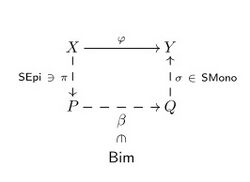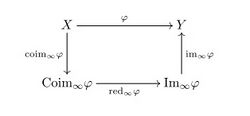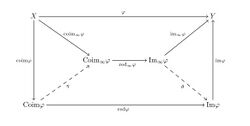Nodal decomposition

In category theory, an abstract mathematical discipline, a nodal decomposition[1] of a morphism
is a representation of
as a product
, where
is a strong epimorphism,[2][3][4]
a bimorphism, and
a strong monomorphism.[5][3][4]
Uniqueness and notations

If it exists, the nodal decomposition is unique up to an isomorphism in the following sense: for any two nodal decompositions
and
there exist isomorphisms
and
such that

This property justifies some special notations for the elements of the nodal decomposition:
– here and are called the nodal coimage of , and the nodal image of , and the nodal reduced part of .
In these notations the nodal decomposition takes the form
Connection with the basic decomposition in pre-abelian categories
In a pre-abelian category each morphism has a standard decomposition
- ,
called the basic decomposition (here , , and are respectively the image, the coimage and the reduced part of the morphism ).

If a morphism
in a pre-abelian category
has a nodal decomposition, then there exist morphisms
and
which (being not necessarily isomorphisms) connect the nodal decomposition with the basic decomposition by the following identities:
Categories with nodal decomposition
A category is called a category with nodal decomposition[1] if each morphism has a nodal decomposition in . This property plays an important role in constructing envelopes and refinements in .
In an abelian category the basic decomposition
is always nodal. As a corollary, all abelian categories have nodal decomposition.
If a pre-abelian category is linearly complete,[6] well-powered in strong monomorphisms[7] and co-well-powered in strong epimorphisms,[8] then has nodal decomposition.[9]
More generally, suppose a category is linearly complete,[6] well-powered in strong monomorphisms,[7] co-well-powered in strong epimorphisms,[8] and in addition strong epimorphisms discern monomorphisms[10] in , and, dually, strong monomorphisms discern epimorphisms[11] in , then has nodal decomposition.[12]
The category Ste of stereotype spaces (being non-abelian) has nodal decomposition,[13] as well as the (non-additive) category SteAlg of stereotype algebras .[14]
Notes
- ↑ 1.0 1.1 Akbarov 2016, p. 28.
- ↑ An epimorphism is said to be strong, if for any monomorphism and for any morphisms and such that there exists a morphism , such that and . thumb
- ↑ 3.0 3.1 Borceux 1994.
- ↑ 4.0 4.1 Tsalenko 1974.
- ↑ A monomorphism is said to be strong, if for any epimorphism and for any morphisms and such that there exists a morphism , such that and
- ↑ 6.0 6.1 A category is said to be linearly complete, if any functor from a linearly ordered set into has direct and inverse limits.
- ↑ 7.0 7.1 A category is said to be well-powered in strong monomorphisms, if for each object the category of all strong monomorphisms into is skeletally small (i.e. has a skeleton which is a set).
- ↑ 8.0 8.1 A category is said to be co-well-powered in strong epimorphisms, if for each object the category of all strong epimorphisms from is skeletally small (i.e. has a skeleton which is a set).
- ↑ Akbarov 2016, p. 37.
- ↑ It is said that strong epimorphisms discern monomorphisms in a category , if each morphism , which is not a monomorphism, can be represented as a composition , where is a strong epimorphism which is not an isomorphism.
- ↑ It is said that strong monomorphisms discern epimorphisms in a category , if each morphism , which is not an epimorphism, can be represented as a composition , where is a strong monomorphism which is not an isomorphism.
- ↑ Akbarov 2016, p. 31.
- ↑ Akbarov 2016, p. 142.
- ↑ Akbarov 2016, p. 164.
References
- Borceux, F. (1994). Handbook of Categorical Algebra 1. Basic Category Theory. Cambridge University Press. ISBN 978-0521061193. https://archive.org/details/handbookofcatego0000borc.
- Tsalenko, M.S.; Shulgeifer, E.G. (1974). Foundations of category theory. Nauka.
- Akbarov, S.S. (2016). "Envelopes and refinements in categories, with applications to functional analysis". Dissertationes Mathematicae 513: 1–188. doi:10.4064/dm702-12-2015. https://www.impan.pl/en/publishing-house/journals-and-series/dissertationes-mathematicae/all/513.
 |
